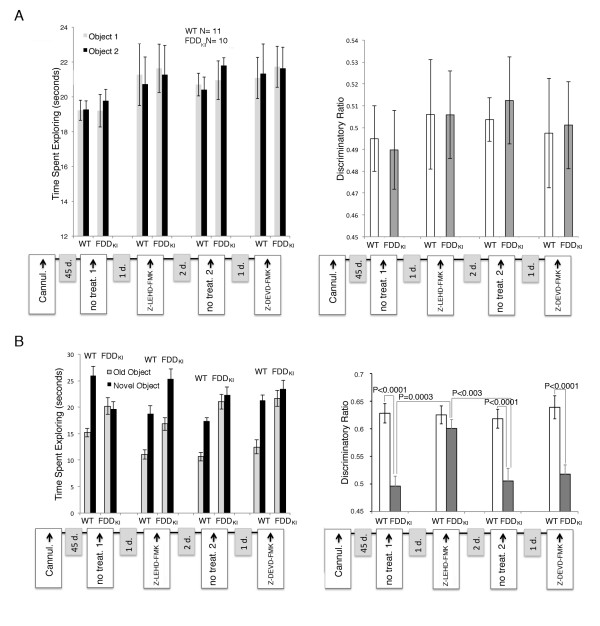Figure 2.
The caspase inhibitor LEHD-fmk rescues the memory deficit of FDDKI mice. Sequential NOR experiments on FDDKI and WT mice. The first NOR was without treatment (no treat. 1); the second was performed after injecting in the lateral ventricle 1 μl of PBS-8%DMSO/800 μM Z-LEHD-fmk (Z-LEHD-fmk); the third NOR was without treatment (no treat. 2); the fourth was performed after injecting 1 μl of PBS-8%DMSO/800 μM Z-DEVD-fmk (Z-DEVD-fmk). The resting-days between each NOR are indicated in the X axis (1d., 2d. and 1d.). Training trials are reported in A as: Time-Spent-Exploring (left panel), discriminatory ratio (right panel), which is calculated as time-spent-exploring Object 1/time-spent-exploring Object 1+ time-spent-exploring Object 2. Data relative to the test trials are reported in B. The discriminatory ratio is calculated as time-spent-exploring the Novel Object/time-spent-exploring the Novel Object + time-spent-exploring Object 2. WT mice spent more time exploring the novel object showing normal object recognition, while FDDKI mice present amnesia and do not distinguish the new object from the old one (B, no treat. 1). Notably, Z-LEHD-fmk rescues the deficit of FDDKI mice while does not affect the NOR of WT mice (Z-LEHD-FMK in B). FDDKI mice relapsed into amnesia (no treat. 2 in B), indicating that the therapeutic effect of Z-LEHD-fmk is short-lived. DEVD-fmk neither rescues the amnesia of FDDKI mice nor it affects the NOR ability of WT mice (Z-DEVD-FMK in B). Objects were changed after each experiment. A paired two-sample t-test was used to test for significance between the discriminatory ratios between the groups.

